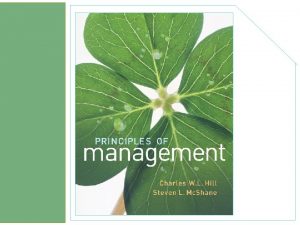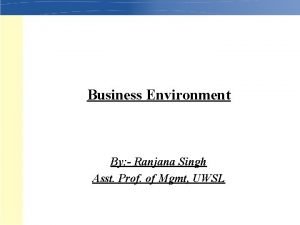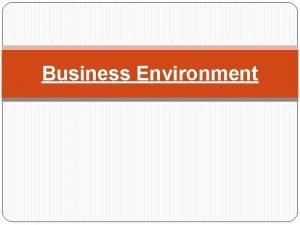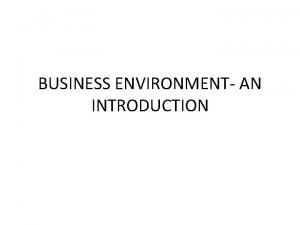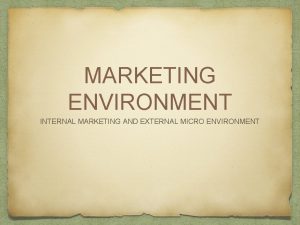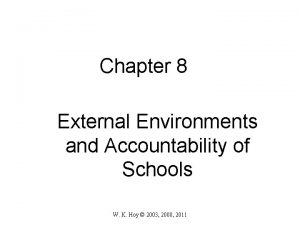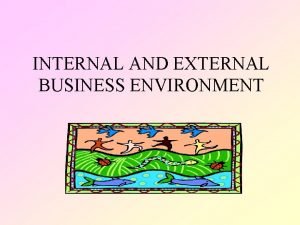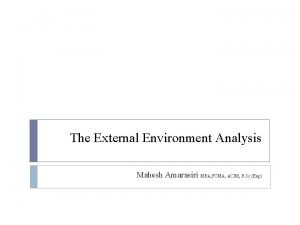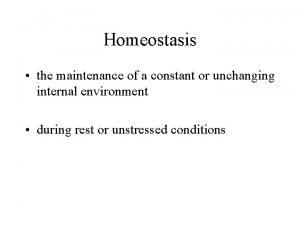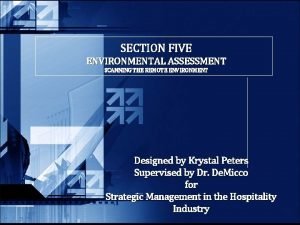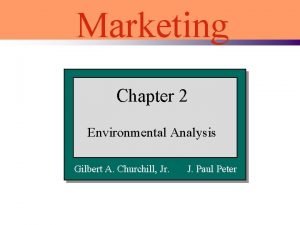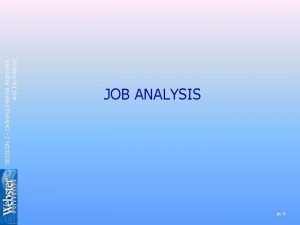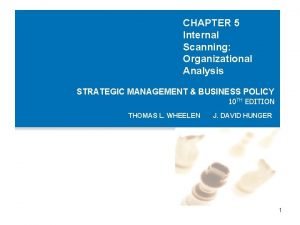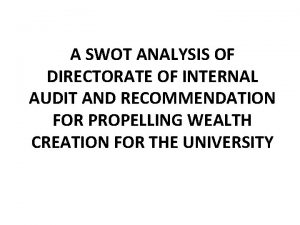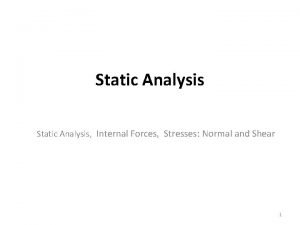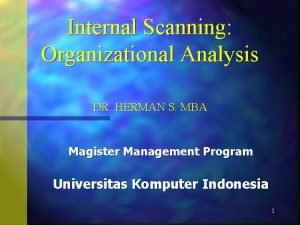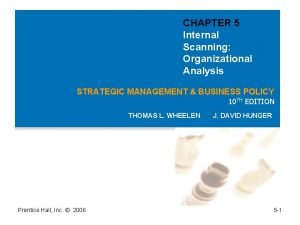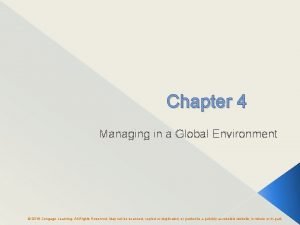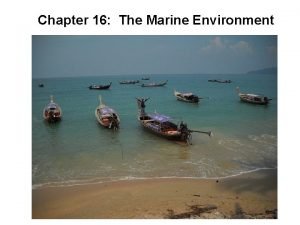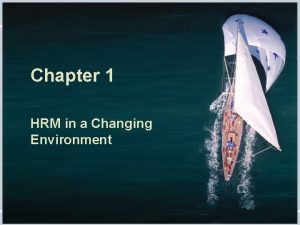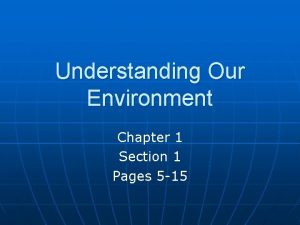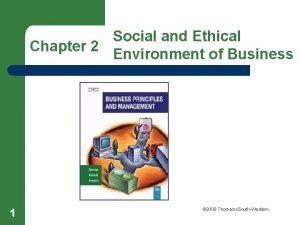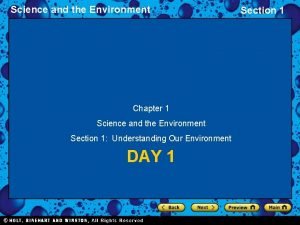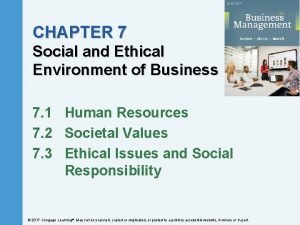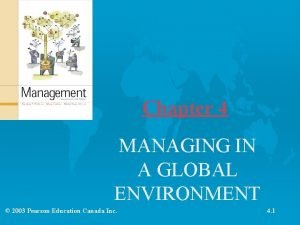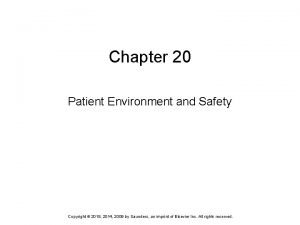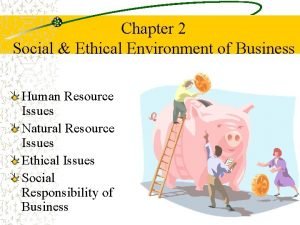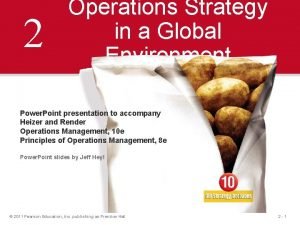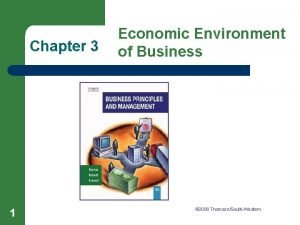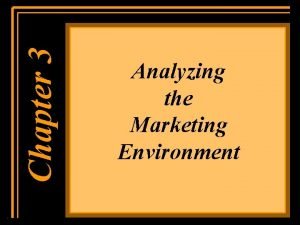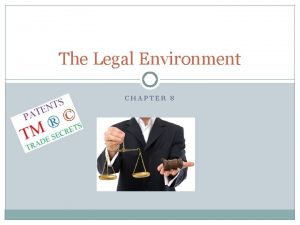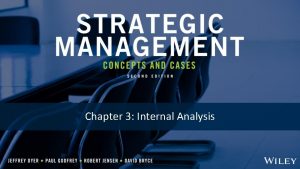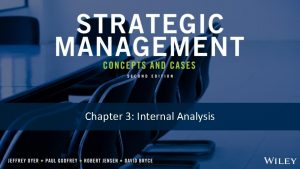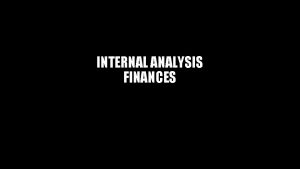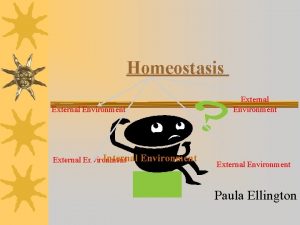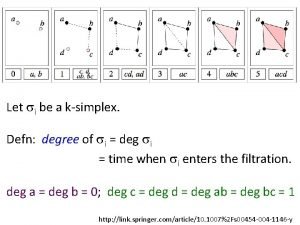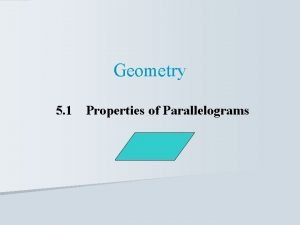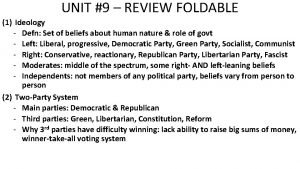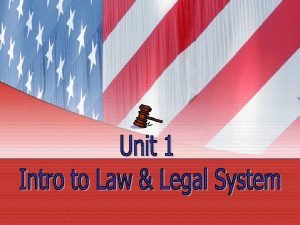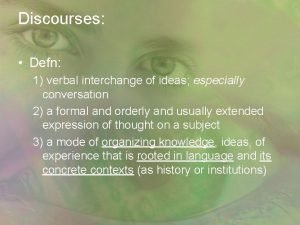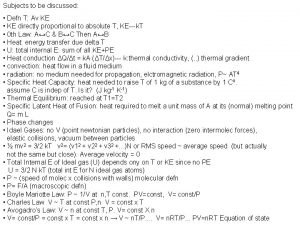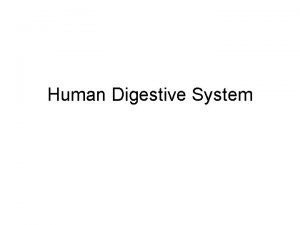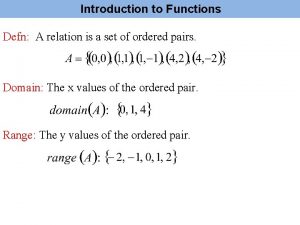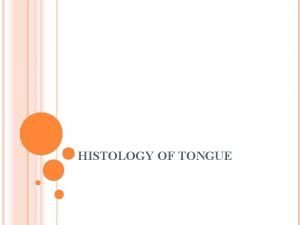Chapter 4 Internal environment Analysis Internal environment defn














































- Slides: 46

Chapter 4 Internal environment Analysis

Internal environment defn � The conditions, entities, events , and factors with in an organization that influence its activities and choices � concerned with providing management with a detail understanding of current strategies and deployment of resources in support of strategies

Internal env’t Analysis -Definition � Internal analysis is the systematic evaluation of the key internal features of an organization � Understanding of current strategies and deployment of resources in support of strategies � Identify and classify variables within an organization as the strength and weakness of a firm � The process by w/c strategist examine the firm’s marketing and distribution, R&D, production and operations , corporate resources and personnel , and finance , information technology and general management factor where the firm has significant strengths and weakness

Purpose of Analysis of internal Environment � To identify resources, competencies, core competences, to be developed and exploited � To evaluate how effectively value adding (input-processoutput)activities are organized � To evaluate the performance of the products � To evaluate the financial performance � To evaluate investment potential � To evaluate the marketing and distribution channel � To evaluate the role of R&D and engineering factor � To evaluate the product performance

Steps in organization Analysis 1. Identify internal factors § § 2. Identify all the crucial factors responsible for the success of an organization Select certain critical factors that assist to the achievement of corporate objectives that could easily be found in functional areas of management Determine the importance of the factor ◦ decide/determine the relative importance of these factor ◦ Some of the strength is more important than others b/c they contribute more ◦ Some internal weakness can provide dangerous , while others are a little consequences

3. Determine strength and weakness ØStrength is an inherent capacity which an organization can use to gain strategic advantage ØWeakness inherent limitation or constraint which creates a strategic disadvantage for an organization 4. Prepare strategic advantage profile § Prepare a strategic advantage profile and organizational capability profile for the firm and compare with it with profile of successful competitors to develop a pattern of the firms strength and weakness

Key internal forces �Resources, capabilities, and core competencies are the foundation of competitive advantage. � Resources are bundled to create organizational capabilities. � In turn, capabilities are the source of a firm’s core competencies, which are the basis of competitive advantages

Components of internal analysis

Resources refer to the assets of a company � A company’s resources two types: tangible and intangible resources. � Tangible resources are physical entities/assets that can be observed and quantified. ◦ Land, buldings, Production equipment, manufacturing facilities, distribution centers, inventory and money � Intangible resources : are nonphysical entities that are created by managers and other employees ◦ are relatively difficult for competitors to analyze and imitate. �Eg. Knowledge, trust between managers and employees, managerial capabilities, organizations scientific capabilities, the capacity for innovation, brand name, and the firm’s reputation and the intellectual property of the company, including patents, copyrights, and trademarks �

Tangible Resources � Financial resources �The firm’s borrowing capacity �The firm’s ability to generate internal funds � Organization resources �The firm’s formal reporting structure and its formal planning, controlling, and coordinating system � Physical Resources �Sophistication and location of a firm’s plant and equipment �Access to raw materials � Technological Resources �Stock of technology, such as patents, trademarks, copy rights and trade secrets

Intangible Resources

Capabilities �A company’s skills at coordinating its resources and putting them to productive use. � exist when resources have been purposely integrated to achieve a specific task or set of tasks. � The foundation of many capabilities lies in the unique skills and knowledge of a firm’s employees and, often, their functional expertise. � Capabilities are intangible. They reside not in individuals, but in the way individuals interact, cooperate, and make decisions within the context of an organization. � capabilities are particularly valuable if they enable a company to create strong demand for its products, and/or to lower its costs

Competencies � Are the special qualities of organization that make them withstand the pressure of competition in the market place. � The capability to use the competencies exceedingly turns them in to core competencies. � Core competencies/distinctive competence-is a specific ability is possessed by a particular organization exclusively or relatively in large measure ◦ Any advantage a company has over its competitor b/c they can do something which they cannot or it can do better than they can ◦ A distinctive competence is unique strength that allow a company to achieve a superior efficiency, quality , innovation or customer responsiveness and there by superior value and achieve a competitive advantage ◦ A firm’s strengths that cannot be easily matched or imitated by competitors

Strategic and competitive Advantage � Strategic Advantage : outcome of organizational capabilities ◦ Are the result of organizational activities leading to reward in terms of �financial parameters i. e profit /shareholders value �Non-financial parameters -. i. e market share , reputation � Competitive Advantage: is a special case of strategic advantage where is one or more identified rivals against whom the reward or penalties could measured.

Sustainable Competitive Advantage � Capabilities must fulfill four specific criteria in order to be CORE COMPETENCIES 1. Valuable 2. Rare 3. Costly-to-imitate 4. Non-substitutable capabilities

� � VALUABLE CAPABILITIES: exploit opportunities Help a firm neutralize threats or RARE CAPABILITIES: Are not possessed by many others � COSTLY-TO-IMITATE CAPABILITIES � • Historical: A unique and a valuable organizational culture or brand name � Ambiguous cause: The causes and uses of a competence are unclear � Social complexity: Interpersonal relationships, trust, and friendship among managers, suppliers, and customers � NONSUBSTITUTABLE CAPABILITIES • No strategic equivalent � Firm-specific knowledge � Organizational culture �Superior execution of the chosen business model

�SUSTAINABLE ADVANTAGE COMPETITIVE 1. Exists only when competitors cannot duplicate a firm’s strategy or when they lack the resources to attempt imitation 2. Exists until competitors can successfully imitate a good, service, or process 3. Lasts for a relatively long period of time if all four of the criteria discussed are satisfied

Analysis of organizational factors � Other terms which an organization factors are strategic factors, strategic advantage factor , corporate competence factors, � Organizational capability factor ( or, simply, capability factors) are the strategic strength and weakness existing in different functional areas within the organization , which are of crucial importance to strategy formulation and implementation � consider capability factors in the six functional areas of finance, marketing, operations, personnel, information , and general management

Financial capability � related to the availability, usage, and management of funds and allied aspects that have a bearing on an organization’s capacity and ability to implement its strategy � the important factors : ◦ Factors related to source of funds ◦ Factors related to usage of funds ◦ Factors related to management of funds � Strength that support financial capability �Access to financial sources �Amicable relationship with financial institutions �High level of credit worthiness �Efficient capital budgeting system �Low cost of capital as compared with competitors �High level of shareholders confidence �Effective management control system

Marketing capability � relate to the pricing, promotion and distribution of product or services and all the allied aspects on an organization’s capacity and ability to implement its strategies � the important factors ◦ Product related factor (i. e. variety , differentiation, mix quality, positioning, packaging ◦ Price related factors(i. e pricing objectivities, policies , changes protection , advantage) ◦ Place related factors (i. e Distribution, transportation and logistics , marketing channels, marketing intermediaries ) ◦ Promotion related Factors ( i. e promotion tools, sales promotion, advertising public relations )

Typical strength that support marketing capability �Wide variety of products �Better quality of products �Sharply –focused positioning �Low prices as compared to those of similar products �High quality customer service �Effective distribution system �Effective sales promotion �Favorable company and product image �Effective marketing management information system

Production capability � relate to the production of products or services , use of material resources and allied aspects that has bearing on an organization's capacity and ability to implement its strategies. � the important factors ◦ Factors related to the product system : Capacity, location, layout, product or service design , work system, degree of automation ◦ Factors related to the operations and Control system: Aggregate production planning, material Supply, inventory, cost and quality control , maintenance system and procedure ◦ Factors related to R&D system: � Example ◦ ◦ ◦ High level of capacity utilization Favorable plant locations Reliable source of vertical integration Effective control of operational cost Existence of good inventory control system

Personnel Capability � relate to the existence and use of human resource and skills , and allied aspects that have bearing on an organization's capacity and ability to implement its strategies � important factors ◦ Factors related to the personnel system: system for manpower planning compensation etc , selection, development, ◦ Factors related to organizational and employee characteristics: corporate image, quality of managers’, staff and workers perceptions about and image of the organization , availability of development opportunities for employees , working condition ◦ Factors related to industrial relations: union-management relationship, collective bargaining , safety, welfare and security , employee satisfactions and morale

� Example ◦ ◦ ◦ Genuine concern for HRM and development Efficient and effective personnel system Excellent training opportunities and facilities Highly satisfied and motivated work force High level of organizations loyalty Safe and salutary working conditions

Information management capability � factors relate to the design and management of the flow of information from outside into, and within an organization for the purpose of decision making and allied aspects that have a bearing on an organization’s capacity and ability to implement its strategies � important factors ◦ Factor related to acquisition and retention of information ◦ Factors related to processing and synthesis of information ◦ Factors related to retrieval and usage of information ◦ Integrative, systematic and supportive factors

Eg. typical strength � Ease and convenience of access to information sources � Widespread use of computerized information system � Availability and operability of high-tech equipment � Positive attitude to sharing and disseminating information � Wide coverage and networking of computer systems

General management Capability � relates to the integration, coordination’s and direction of the functional capabilities towards common goals and allied aspects that have a bearing on an organization’s capacity and ability to implement its strategies � important factors ◦ Factors related to the general management system ◦ Factors related to general manager ◦ Factors related to the organizational climate � Example ◦ Effective system for corporate planning ◦ Control, reward and incentive system for top managers geared to the achieve of objectives ◦ Entrepreneurial orientation and high propensity of risk taking ◦ Favorable corporate image

Techniques used for organizational Appraisal � used for organizational appraisal can be identical to those who used for the performance evaluation of the organization � techniques used could be classified as broadly in three parts as below Internal Analysis � VRIO framework -Value chain analysis � Quantitative analysis -Qualitative analysis -Financial analysis -Non- financial analysis Comparative Analysis -Historical analysis -Industry norms - Bench marking � Comprehensive Analysis -Key factor rating -Business intelligence system -Balanced scorecard

Internal Analysis � The internal analysis of an organization deals with an investigation into its strength and weakness by focusing on factors that are specific to it A. VRIO framework: Valuable, rare, inimitable and organized for usage � Valuable: helps a firm to generate revenue by capitalizing on opportunities and/or to reduce costs by neutralizing threats � Rare: the possessed by the firm exclusively or just by a few other firms in the industry. � Inimitable : impossible , very difficult or not worthwhile to duplicate or substituted by the competitor � Organization for usage: appropriate organizational structure , business process, control systems and reward system that are present in the firm

Are the capabilities valuable? Are the capabilities rare? Are the capabilities cost to imitate? Are the capabilities organized to usage? Are the capabilities strength or weakness? no - - No Weakness yes no - yes Strength yes no yes Strength and distinctive competence yes yes Strength and sustainable distinctive competence

Value Chain Analysis � The term value chain refers to the idea that a company is a chain of activities that transforms inputs into outputs that customers value § Assessing the strength and weakness of an organization based on an understanding of the series of activities it performs. § A value chain is a set of interlinked value-creating activities performed by an organization. § The value chain of a manufacturing organization can divide into § Primary and § supporting activities


Primary activities � are directly related to the flow of the product to the customer and include five sub activities as listed below � Inbound logistics: All activities that an organization uses for receiving, storing and transporting inputs going into the production process � Operations: All activities required for transformations of raw materials to finished products � Outbound logistics: all activities that an organization uses for receiving , storing and transporting outputs going out of the production process � Marketing and sales: All activities that an organization uses to market and sell its product to customers � Service: All activities that an organization uses for

Support activities � provide the assistance necessary for the primary activities to take place these consist of � Firm infrastructure; consists of many activities � Human resource management: all activities that an organization uses for managing human resource � Technology development: All activities that an organization uses for creating, developing, and improving products and services � Procurement: All activities that an organization uses for procuring inputs needed to produce products or provide services

The value chain analysis requires(steps) � Identifying activities that make up the organizations value chain and classifying them into � primary and �supporting activities � Identify the things done in those activities that contribute to providing value for the customer � Identifying how the value contribution can be increased so that it costs less to provide the same or more value, thereby increasing the profit margin for the organization � Identifying how the value configuration can be improved by innovatively reconfiguring or recombining activities

Quantitative analysis A. Financial analysis-the traditional method used for evaluating financial performance, cover various types of activities in different functional areas within an organization � Technique �Ratio Analysis �Economic value Added �Activity Based costing B. Non-financial quantities analysis : The expression of several intangibles of an organization in monetary terms is neither possible nor desirable C. Qualitative analysis: Quantitative tools cannot be applied to all internal factors, and the normative judgments of key planning participants may be used in evaluation

Comparative analysis � Historical Analysis: one way to compare its own organizations over a period of time. ◦ measure of how well or badly an organization has progressed with respect to its own past performance. � Industry norm: the may determinants of success in industry may be used to identify the strength and weakness of a firm. � Benchmarking: A bench mark is a reference point for taking measure against. �aimed at finding the best practices within and outside the industry to which an organization belongs

Types of benchmarking � Based on finding what is compared �Performance benchmarking �Process benchmarking �Strategic benchmarking � Based on whom it should compare itself �Internal benchmarking �Competitive benchmarking �Functional benchmarking �Generic benchmarking

Comprehensive analysis � Business Intelligence system �A broad category of applications and technologies for gathering, storing, analyzing, and providing access to data to help enterprise users make better business decision �Eg Decision support system, online analytical processing, statistical analysis , forecasting � Balanced Scorecard/BSC/: ◦ to build a holistic system of measurements ◦ complements that financial measures on customer satisfaction, internal process , and organizational processes, and the organization’s innovation and improvement activities

Cont. . � The BSC identifies four key performance measures as follows �Customer perspective : “how do customers see us” �Internal business perspective: ”what must we excel at? ’ �Innovation and learning perspective: ”can we continue to improve and create value? ” �Financial perspective: ”how do we look at shareholders”

SWOT analysis � Strengths – what the organization does well, features it should build on � Weaknesses – problems the organization has, areas it should improve � Opportunities – openings that can help the organization � Threats – hazards that can damage it.

� Strengths and weaknesses concern the organization's internal operations and show its distinctive competence. ◦ Strengths are positive internal characteristics that the organization can exploit to achieve its strategic performance goals. ◦ Weaknesses are internal characteristics that might inhibit or restrict the organization’s performance. � Opportunities and threats relate to external concentrating on the business environment. features, ◦ Threats are characteristics of the external environment that may prevent the organization from achieving its strategic goals. ◦ Opportunities are characteristics of the external environment that have the potential to help the organization achieve or exceed its strategic goal

Cont… simple application of SWOT analysis involves these steps 1. Setting the objective of the organization or its unit 2. Identify strength, weakness, opportunity and threat 3. Ask the following question how do we maximize our strength? how do we minimize our weakness? How do we capitalize opportunities? How e do protect ourselves from threat? 4. Recommending strategies that will optimize the answer from the four questions? �



Structuring organizational Analysis Preparing Strategic advantage profile § Strategic Advantage profile : is a detailed document that divides each of the function or factors into several subsectors 2. Preparing capability profile: Capability profile § A techniques of assigning weight to each factor to determine the degree to which a factor is an advantage or disadvantage § Helps as a tool to assess the relative strengths and weakness of an organization in each of the functional areas and identify the gap that need to be filled 1.
 Financial environment in business environment
Financial environment in business environment Internal environment of an organization
Internal environment of an organization Components of internal business environment
Components of internal business environment Busniess goals
Busniess goals Micro environment factors
Micro environment factors Introduction for business environment
Introduction for business environment Internal business environment factors
Internal business environment factors Micro environment of samsung
Micro environment of samsung Example of external environment in school
Example of external environment in school Stable internal environment
Stable internal environment Internal and external business environment
Internal and external business environment Components of internal environment
Components of internal environment Maintenance of a constant internal environment
Maintenance of a constant internal environment Assessing the internal environment of the firm
Assessing the internal environment of the firm Introduction to internal control
Introduction to internal control Features of vouching
Features of vouching Types of retail environment
Types of retail environment Environment analysis in curriculum design
Environment analysis in curriculum design Remote environment analysis
Remote environment analysis Environment analysis in language curriculum design
Environment analysis in language curriculum design Natural environment analysis
Natural environment analysis What does job analysis have to do with internal alignment?
What does job analysis have to do with internal alignment? Superfluous strengths examples
Superfluous strengths examples Internal scanning organizational analysis
Internal scanning organizational analysis Swot analysis for internal audit department
Swot analysis for internal audit department Hcci engine advantages and disadvantages
Hcci engine advantages and disadvantages Fbd
Fbd Internal scanning organizational analysis
Internal scanning organizational analysis Scanning functional resources
Scanning functional resources Managing in a global environment chapter 4
Managing in a global environment chapter 4 Chapter 16 the marine environment
Chapter 16 the marine environment Chapter 1 hrm in a changing environment
Chapter 1 hrm in a changing environment Chapter 1 science and the environment answer key
Chapter 1 science and the environment answer key Chapter 1 science and the environment
Chapter 1 science and the environment Managing in a global environment chapter 4
Managing in a global environment chapter 4 Chapter 1 section 1 understanding our environment answers
Chapter 1 section 1 understanding our environment answers Chapter 2 social and ethical environment of business
Chapter 2 social and ethical environment of business Chapter 1 science and the environment section 2
Chapter 1 science and the environment section 2 Chapter 7 social and ethical environment of business
Chapter 7 social and ethical environment of business Managing in a global environment chapter 4
Managing in a global environment chapter 4 Patient environment and safety
Patient environment and safety Chapter 2 social and ethical environment of business
Chapter 2 social and ethical environment of business The investment environment chapter 1 ppt
The investment environment chapter 1 ppt Operations strategy in a global environment
Operations strategy in a global environment The legal environment of business chapter 3 problem 7bcp
The legal environment of business chapter 3 problem 7bcp Marketing environment case study
Marketing environment case study The legal environment of business chapter 8 problem 9bcp
The legal environment of business chapter 8 problem 9bcp

